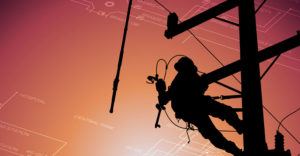
The 2013 Atlantic hurricane season is quietly underway. Gear is available, however, that can help mitigate potential office disruption as weather ramps up.
Uninterruptible power supplies are sophisticated battery-containing devices that supply backup power to desktop PCs during grid electricity outages, like in storms. You can pick up a UPS at office supply retailers, among other places. They’re great to have because the battery lets you keep working during short outages, and they let you shut down a desktop computer normally in the event of a longer outage without losing data.
They also protect the PC from brown-outs and spikes through circuitry.
Much of this power management can be accomplished with software that comes included with the UPS, so even when the PC is unattended, like over lunch, the UPS will sense any outage and shut down the PC safely and automatically using the available battery power, thus saving your files.
See update published May 28, 2019:How to Set Up Your Computer to Auto-Restart After a Power Outage
If you have a UPS, or are considering buying one for this year’s storm season, you should also know about a little-known trick available on newer PCs, and that is to get the PC to start up again — with no intervention by you — when the power comes back on.
This is useful when taking advantage of remote PC access services like GoToMyPC and file-syncing with SugarSync-like services. Otherwise, you’d have to physically switch the PC back on again, which might be inconvenient or impossible at the time.
Getting your PC to restart automatically after a power outage involves getting the computer to “see” the power returning by making some changes to the PC’s BIOS settings and installing the UPS-included software. Here’s how to go about it.
Verify the PC Is Capable
Step 1: Open your computer’s BIOS settings menu. Do this by restarting the computer and observing the first flash-screen that appears. This will be the black screen with white text that shows before Windows loads — assuming you’re using Microsoft’s operating system.
Look for the Setup function key description. It will be “Setup F2” or F12, or something similar.Restart the computer and at the same time press the appropriate function key. Tap the key repeatedly during this initial startup period and the BIOS Settings menu will appear.
Step 2:Look for the Power Settings menu item within the BIOS and change the AC Power Recovery, or similar, setting to “On.” You are looking for a power-based setting that affirms that the PC will power on when power becomes available.
Some older PCs don’t have this setting and so aren’t capable.
Step 3: Save the configuration and reboot the computer.
Make the Hardware Connections
Step 1: Plug the PC and monitor into available controlled AC outlets on the UPS.I’ve been using a Schneider Electric APC Back-UPS Pro 1500 (about US$190 at Amazon), which ships with PowerChute Personal Edition power management software that’s compatible with unattended shutdown and restart.
Step 2: Connect the included USB cable between UPS and PC. It’s used for communications.
Tip: Don’t use a powered USB hub between UPS and PC, or the lack of power during an outage will cause communications to fail.
Step 3: Plug the UPS into the wall power supply and allow it to charge. My APC takes about four hours to do this.
Install and Configure the UPS Software
Step 1: Install the PowerChute or similar software.
Step 2: Navigate to the Energy Management tab or similar within the Configuration setting.
Step 3: Check the Enable Energy Management checkbox and choose the Default settings in PowerChute. Look for any “Turn On Again” settings in any other power management software and check as appropriate.
Now smile, because your computer will gracefully shut down during a power outage and start up again when power is restored.
Want to Ask a Tech Question?
Is there a piece of tech you’d like to know how to operate properly? Is there a gadget that’s got you confounded? Please send your tech questions to me, and I’ll try to answer as many as possible in this column.
And use the Talkback feature below to add your comments!






















































